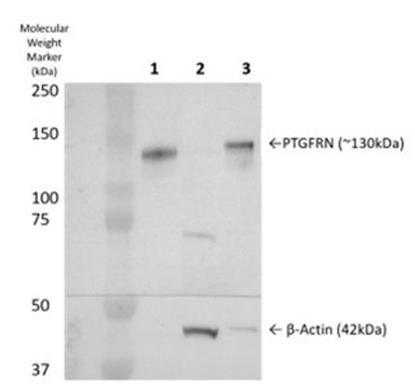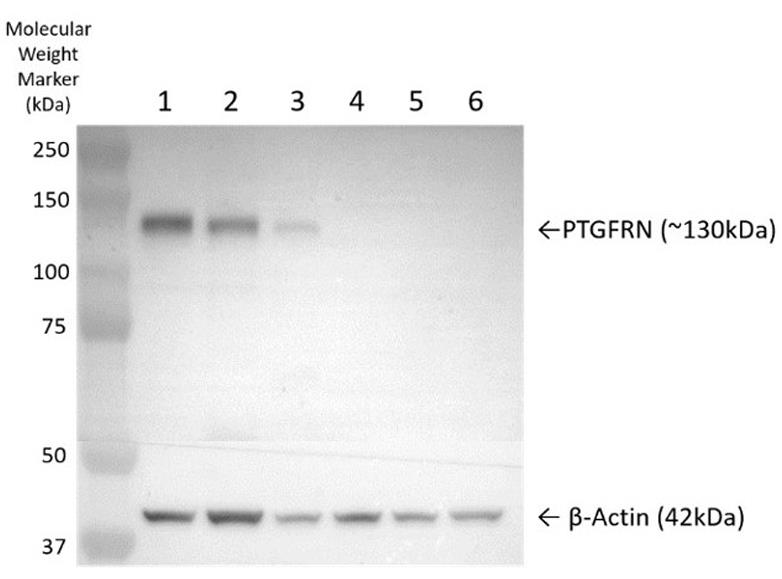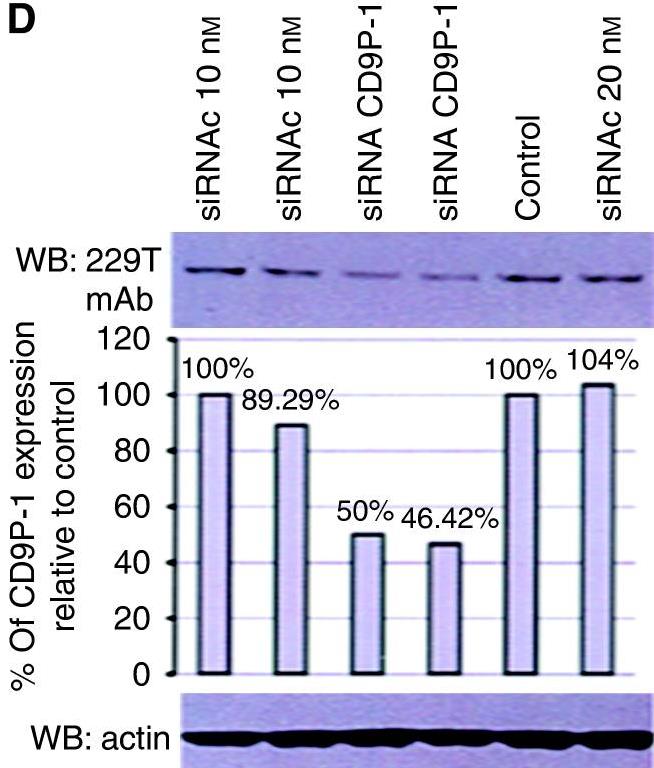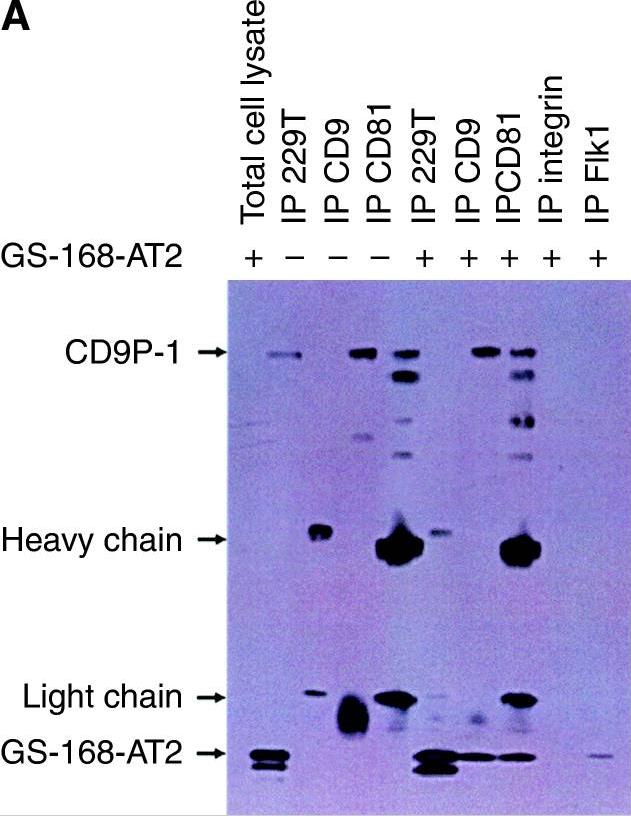PTGFRN
-
Official Full Name
prostaglandin F2 receptor negative regulator -
Synonyms
PTGFRN;prostaglandin F2 receptor negative regulator;9601;ENSG00000134247;FPRP;CD315;EWI-F;CD9P-1;SMAP-6;1p13.1;FLJ11001, KIAA1436;prostaglandin F2 receptor negative regulator;prostaglandin F2 receptor negative regulator;CD9 partner 1;glu-Trp-Ile EWI motif-containing protein F;prostaglandin F2-alpha receptor regulatory protein;prostaglandin F2-alpha receptor-associated protein
Recombinant Proteins
- Human
- Mouse
- Cynomolgus
- Rat
- E.coli
- HEK293
- Mammalian Cells
- Human Cells
- His
- T7
- Non
- Avi
- Fc
Background
What is PTGFRN Protein?
PTGFRN protein, often called "Prostaglandin F2 receptor negative regulator," acts like a manager in the cellular world. It helps regulate how cells respond to prostaglandins, which are chemicals that influence things like inflammation and blood flow. PTGFRN is involved in various bodily processes and has caught the attention of researchers for its potential role in conditions related to inflammation and immune responses. This protein's ability to modulate responses makes it an interesting target for new therapeutic approaches.What is the Function of PTGFRN Protein?
PTGFRN protein's main gig is to keep tabs on how cells react to prostaglandins, which are like little messengers for things like inflammation and blood flow. By doing this, PTGFRN ensures that the cellular responses don't go overboard, acting as a sort of balance keeper. This function is key in maintaining normal bodily functions and preventing excessive inflammatory reactions. Researchers are interested in this protein because of its potential role in managing inflammation and related health issues.PTGFRN Related Signaling Pathway
The PTGFRN signaling pathway is like a control room for managing how cells deal with prostaglandins, which are important for inflammation and blood flow. This pathway helps keep cell responses in check, preventing any overreaction that might lead to inflammation-related issues. By understanding how this pathway works, scientists are hoping to find new ways to treat conditions where inflammation goes haywire, potentially leading to new therapies that target these cellular communications.PTGFRN Related Diseases
PTGFRN is linked to a bunch of health issues because of its role in controlling inflammation and cell communication. When PTGFRN isn't doing its job properly, it can be tied to diseases where inflammation runs wild, like certain autoimmune disorders. Researchers are digging into how PTGFRN works to better understand its connection to these diseases, hoping to discover new ways to manage or even prevent them by targeting this protein.Bioapplications of PTGFRN
PTGFRN has some cool bioapplications because it helps control inflammation. Researchers are exploring how tweaking this protein might offer new ways to treat diseases where inflammation is a problem, like autoimmune disorders. By getting a handle on PTGFRN's functions, they hope to create therapies that adjust the immune response and improve healing, giving us better tools to fix issues when the body's response gets out of line.Case Study
Case Study 1: Marquez J. et al. PLoS One. 2021
Antibody-drug conjugates (ADCs) work for blood cancers, but need more targets for solid tumors. Researchers found the antibody 33B7 from a library, which binds to cancer cells. It targets the protein PTGFRN. Tests confirmed PTGFRN-positive cells attach to 33B7. In the lab and in mice, 33B7 coupled with saporin stopped cancer growth. This approach can help discover new ADC targets.-
 Fig1. PTGFRN expression visualized by Western Blot.
Fig1. PTGFRN expression visualized by Western Blot. -
 Fig2. PTGFRN expression by Western Blot with anti-PTGFRN antibody.
Fig2. PTGFRN expression by Western Blot with anti-PTGFRN antibody.
Case Study 2: Guilmain W. et al. Br J Cancer. 2011
Loss of CD9 is linked to tumor cells spreading faster, but why this happens isn't clear yet. We made a truncated CD9 partner, GS-168AT2, and created an antibody for it. We checked CD9 and CD9P-1 levels in human lung tumors and looked at CD9 in NCI-H460 cells with or without GS-168AT2. We found that when CD9 goes down, CD9P-1 goes up, tying it to how aggressive the cancer is. GS-168AT2 is quickly taken in and broken down in the cells and interacts with CD9 and CD81. Injecting GS-168AT2 into mice with tumors greatly cut tumor growth and lowered CD9, but not CD81, in tumors.-
 Fig3. NCI-H-460 cells were transfected either with nonspecific siRNA (siRNAc) as control or with siRNA specific to CD9P-1.
Fig3. NCI-H-460 cells were transfected either with nonspecific siRNA (siRNAc) as control or with siRNA specific to CD9P-1. -
 Fig4. The degradation of GS-168AT2 is associated with its interaction with CD9 and CD81.
Fig4. The degradation of GS-168AT2 is associated with its interaction with CD9 and CD81.
Quality Guarantee
High Purity
-
.jpg) Fig1. SDS-PAGE (PTGFRN-0972H)
Fig1. SDS-PAGE (PTGFRN-0972H) -
.jpg) Fig2. SDS-PAGE (PTGFRN-5038H)
Fig2. SDS-PAGE (PTGFRN-5038H)
Involved Pathway
PTGFRN involved in several pathways and played different roles in them. We selected most pathways PTGFRN participated on our site, such as , which may be useful for your reference. Also, other proteins which involved in the same pathway with PTGFRN were listed below. Creative BioMart supplied nearly all the proteins listed, you can search them on our site.
| Pathway Name | Pathway Related Protein |
|---|
Protein Function
PTGFRN has several biochemical functions, for example, protein binding. Some of the functions are cooperated with other proteins, some of the functions could acted by PTGFRN itself. We selected most functions PTGFRN had, and list some proteins which have the same functions with PTGFRN. You can find most of the proteins on our site.
| Function | Related Protein |
|---|---|
| protein binding | MTIF3,RAP2A,ENTPD3,BBOX1,ETF1,ACAA2,MGST3,SART3,ARR3,HFE |
Interacting Protein
PTGFRN has direct interactions with proteins and molecules. Those interactions were detected by several methods such as yeast two hybrid, co-IP, pull-down and so on. We selected proteins and molecules interacted with PTGFRN here. Most of them are supplied by our site. Hope this information will be useful for your research of PTGFRN.
CD9
Resources
Related Services
Related Products
References
- Mechsner, SV; Bartley, J; et al. Oxytocin receptor expression in smooth muscle cells of peritoneal endometriotic lesions and ovarian endometriotic cysts. FERTILITY AND STERILITY 83:1220-1231(2005).
- Tai, CJ; Kang, SK; et al. Adenosine triphosphate activates mitogen-activated protein kinase in human granulosa-luteal cells. ENDOCRINOLOGY 142:1554-1560(2001).


